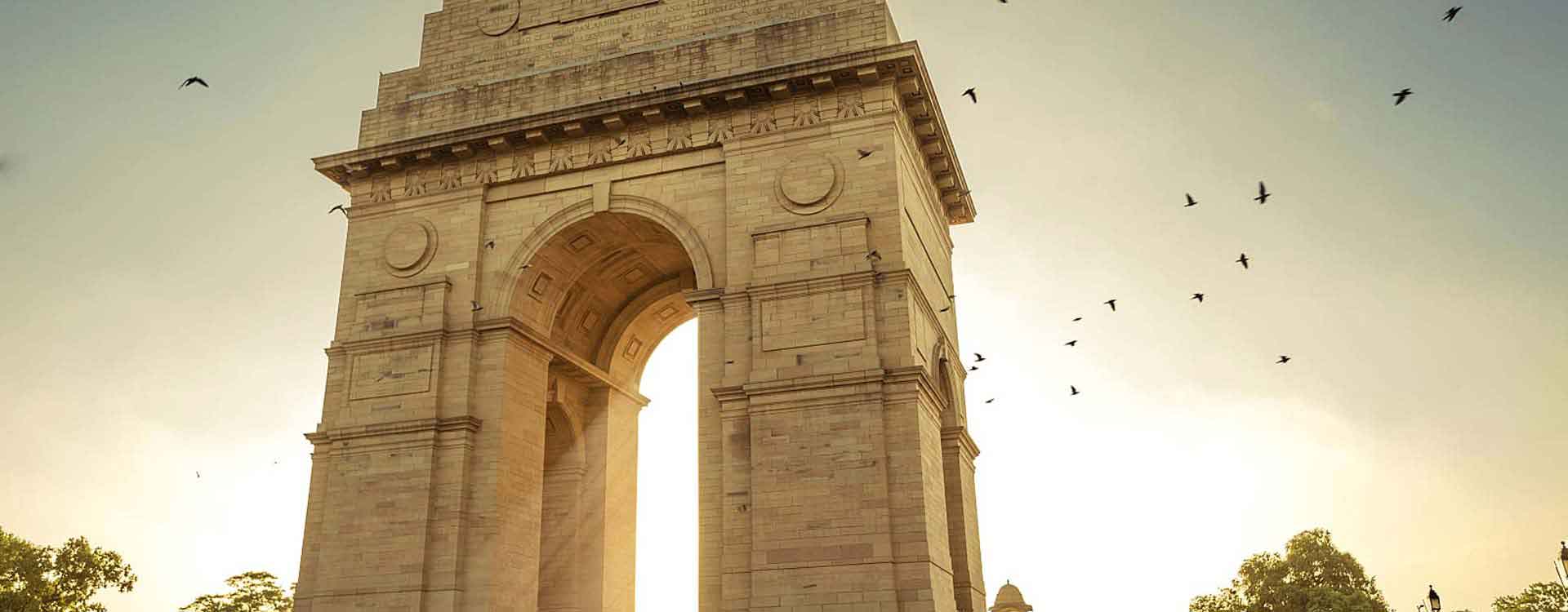Delhi is the capital city of India and is regarded as the heart of the nation. The city is popular for its enriched culture and heritage. The city hosts some famous historical monuments and is developing with the passing of time.The influence of religious diversity can be seen in the city along with the cultural impact of the Mughal, the ancient Indian and the British. There are many beautiful gardens in the city, away from pollution and busy city life that provide opportunities to walk leisurely in the midst of greenery.
The capital city is divided into two sections popularly known as Purani Dilli or Old Delhi and Nayi Dilli or New Delhi. Old Delhi is popular for its ancient culture and monuments along with its overcrowded gastronomical lanes. You can explore Delhi by booking various packages like: Delhi Same Day Tours, Delhi Tour Packages & more. Let’s have a quick peek into the different aspects of Delhi below.
Old Delhi
Mughal Emperor Shahjahan founded Old Delhi in 1639 which was formerly known as Shahjahanabad. Till the end of Mughal dynasty it remained the capital of the Mughals. During ancient times, the city was known for housing exquisitely designed mosques, beautiful gardens, and magnificent mansions of members and nobles of the royal court. Though this part of Delhi has become extremely crowded yet it symbolizes the heart of Delhi.
The Mughals built many palaces and forts in Delhi. The wall city was built by Shah Jahan in between 1638 to 1649, including the Chandni Chowk and the Lal Qila. The original cantonment of Delhi was at Daryaganj which later shifted to Ridge area. Old Delhi had the first wholesale market and the first hardware market was opened in Chawri Bazaar in the year 1840. Then the next wholesale market was opened at Khari Baoli which was of dry fruits, herbs and spices in 1850. Daryaganj also had a Phool Mandi (Flower Market), established in 1869. Though the area is small and densely populated it holds much importance.
The capital of India was shifted to Calcutta post 1857 revolt and after the fall of the Mughal Empire. It remained the capital until 1911. So, Lutyens’ Delhi was developed after the change was declared. It was developed in New Delhi located south-west of Shahjahanabad. Therefore, the Old Delhi was named so and New Delhi was considered as the seat of national government then. In the year 1931, it was officially inaugurated. Some people moved out of the walled city by 1930s as it became congested and areas around the city were getting developed.
New Delhi
The remarkable Indian Capital was architecturally designed by the British architect Edwin Lutyens and was named after him. It has a pleasant contrast to the twisted streets of Old Delhi. Enriched with history and culture, the impressive avenues and imperial buildings of New Delhi are included in the list of attractions. Humayun’s Tomb, Gandhi Ji's Delhi home, the site where he was assassinated are all located in New Delhi that draws a large number of tourists every year. Akshardham Temple, India Gate and Gurudwara Bangla Sahib are some of the major attractions of New Delhi.
Various shopping malls and local markets are there for the locals and the visitors, providing them a wide option to shop in the city. Other options of entertainment are also available in the city such as discs, cafes, cinema halls. Wide options for eating out in the city are there as the capital city houses numerous eating outlets and restaurants serving relishing and traditional cuisines.
Delhi is well connected with the neighboring regions and other major cities of India through all modes of transport such as airways, railways and roadways. The traffic of New Delhi remains busy and chaotic because of increased population and vehicles. One needs to negotiate on fare for taxis and autos while hiring to travel within the city. One can also opt for the safest, convenient and quickest mode of transport - the Metro Rail to travel across the city and to its nearby regions.
If you are planning to visit Delhi by taking Delhi Tour Packages, Delhi Day Tours, Delhi Same Day Tours, know properly about the city before packing your travel bags. We will help you to have in depth knowledge about the city and will give you travel tip as well.
Places to Visit in Delhi
Delhi has been the central seat of power in India since ages, be it the Mughal era or the British colonial era. It is now the capital of India and is dotted with many grand and beautiful monuments constructed by the greatest kings this world has ever seen. Let us have a look at the top ten monuments that should be surely there in your travel schedule when you come to visit Delhi:
Red Fort
The crowning glory of Delhi is the grand fortress called Red Fort owned by the Mughal dynasty. This monument is situated in Old Delhi, is the largest of all monuments in the city and houses museums displaying ancient archaeology, the stories of martyrs and Indian wars etc. This monument is built in red sandstone and that’s why is called the Red Fort. Like any mughal fortress it has features like Diwan-e-Aam, Diwan-e-Khas, several gardens etc in its complex. One can go for the light and sound show that is put up here every evening to describe the glory of Mughal era.
Jama Masjid
Jama Masjid is the largest mosque in India and is one of the most serene places to visit in Delhi. It is a deeply revered worship place among the Muslim community and they come here to put forward their requests or ‘arziyaan’ in the hope that ‘Allah’ will fulfil their wishes. Such is the grandeur that the Masjid can accommodate 25,000 people praying at the same time.
Qutub Minar
Qutub Minar is the second tallest minaret in India. It was built as a mark of victory by Qutab-Ud-Din-Aibak to commemorate his triumph over the Hindu dynasty. It has now been given the title of UNESCO world heritage site due to the Arabic inscriptions on it. Such is the fame of this monument that a its picture appears on the Delhi Metro Rail Corporation Travel cards.
India Gate
Constructed by the British to commemorate the sacrifices of Indian soldiers in World War I, this is also known as the All India War Memorial. Located on the Rajpath, it is now a monument of national importance as on the Republic Day the parade comes to India Gate to pay a tribute to all the Indian war heroes who lost their lives for the pride of their country. Not to miss Amar Jawan Jyoti, the ever burning flame of which signifies that soldiers who lost his life saving the honour of India are immortal
Humayun’s Tomb
Situated on the Mathura Road, this is the burial or mausoleum of Humayun and it is one of the significant constructions done during the Mughal Rule. It was built by Haji Begum (the wife of Humayun) using the characteristic red sandstone which always had a special place in the Mughal architecture. Very recently in the early 1990s it was put in the list of UNESCO World heritage sites.
Jantar Mantar
This is one of the five astronomical observatories built by Sawai Jai Singh II, the ruler of Amber region in Rajasthan. This observatory was built by Jai Singh due to he being instructed to revise the astronomical tables and calendar by the then Mughal ruler and also because he had interest in the subject of astronomy himself. One can find here massive architectural astronomical objects which help study the movements of planets, sun and moon. The spectator will be spell bound for sure on having a look of these.
Lotus Temple
This temple is a hit among the tourists coming to Delhi. The magnificent architecture and the peaceful aura are two things that will be greatly admired by the visitors. This temple has got such a name because it is built in the shape of a lotus. It is not dedicated to a particular God as it is a Baha’i faith temple which believes in equality and oneness of all religions. One can just sit in the hall and meditate in the calmness.
Rashtrapati Bhawan
India’s president’s house or the Rastrapati Bhawan (as called in Hindi) is one of the most grand and glorious structures standing in Delhi. It was originally built as the viceroy’s lodge during the British rule. The Rasthrapati Bhawan’s very famous tourist attraction is Mughal Garden which has numerous varieties of flowers. This is open for tourists in February -March every year. Events of national importance are hosted here like the swearing in ceremony of Prime Minister, cabinet, presenting of Arjuna Awards etc.
Best Time to Visit in Delhi
Delhi offers much to see and do all through the year. Here's a seasonal break-up so you can plan your trip accordingly: October to March: The start of autumn, which gradually leads to a crisp and pleasant winter, this is the best time to visit Delhi. Winters in the capital can get really cold, with the minimum temperature dropping down to 2 degrees Celsius in the month of January, but afternoons are mostly sunny and pleasant. Enjoy sightseeing, shopping or just ambling through the sun bathed streets of Delhi. Don’t forget to carry your woolens along, as mornings and evenings can get particularly cold. October is also the time for one of Delhi's biggest festivities - Diwali. Visit Delhi during Diwali or Dussehra, and you will be welcomed by a beautifully decorated city bustling with activity. This is also the time when Delhi hosts a number of film, drama, music and literature festivals.
April to June
This is the beginning of summer and when tourists generally tend to retreat. It's the perfect time to have Delhi all to yourself and take advantage of off season hotel prices. During summers the temperatures can go up to 45 degrees Celsius. End May and June are the hottest months. Make sure you carry light cotton clothes, sunscreen and sunglasses to beat the heat and enjoy the sights of the city.
July to September
July marks the beginning of monsoon and this is when you can enjoy Delhi in its rain washed splendour. Monsoons in Delhi are when the city is at its most beautiful. This is also a great time to enjoy Delhi’s lush green parks and gardens. Don’t forget to carry an umbrella or a raincoat.
How to Reach Delhi
The Delhi is regarded as a hub of administration, finance and IT with its prominent surroundings of NCR (National Capital Region) Noida and Gurgaon. The capital city of India is making continuous progress and draws tourists from all over the world. The city is also frequented by the politicians from various countries. If one is planning to visit this city of historical beauty, he or she should not worry about how to reach there. As Delhi is well connected in terms of airways, railways and roadways one can easily reach there through any mode of transport according to their convenience.
By Air
The Indira Gandhi International Airport, which is the biggest airport of India, is located in the western part of Delhi. All the major cities of the world are connected through terminal 1 of Indira Gandhi International Airport, popularly known as the New Delhi Airport. The flights to major domestic cities have access from the same terminal. It provides excellent facilities like cafeteria, shopping centers, coffee shops, duty free shops, eating outlets, cyber cafes and many more. You can plan your journey from any part of India and can have a hassle traveling experience.
By Road
The state bus service providers Delhi Transport Corporation (DTC), operates the largest fleet of CNG buses. These eco-friendly buses connect the city with other neighboring cities through road routes. The three major bus terminus of Delhi are Inter State Bus Terminus (ISBT) at Kashmiri Gate, Sarai Kale-Khan Bus Terminus and Anand Vihar Bus Terminus that operate buses for several routes.
The city has a good network of Government and private transport services provide frequent bus services to and from various part of the city. Private taxis can also be hired for traveling within and around the city.
By Rail
Being the headquarter of Northern Railways Delhi is considered as a major railway junctions according to the rail map of India. There are two major Railway Stations in the capital city - the New Delhi Railway Station and the Old Delhi Railway Station, connecting the city with other prominent cities of the country. Besides, there are substitutes like the Nizamuddin Railway Station, Sarai Rohilla and Anand Vihar Railway Station.
The New Delhi Railway Station provide access to the Rajdhani Expresses that connects the metropolitan cities like Hyderabad, Bangalore, Ahmedabad, Guwahati, Patna, Bhubaneshwar and Indore. Trains running to Delhi from different states/cities of India remains reserved throughout the year. Therefore one has to get his or her tickets booked in advance in order to avoid last moment tension.
The neighboring places of Delhi like Noida, Gurgaon and Ghaziabad are well connected through the majestic technology of Metro Rails under Delhi Metro Rail Corporation (DMRC).






